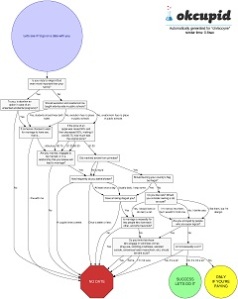Customer segmentation is critical when developing strategy for customer acquisition and retention. But will it cause your customers to develop an inferiority complex? Probably not, but this new service might.
 OKCupid.com has taken the application of predictive analytics to a whole new level by ranking and segmenting the more attractive site users from the less aesthetically pleasing ones. A recent post on Mashable explains it this way:
OKCupid.com has taken the application of predictive analytics to a whole new level by ranking and segmenting the more attractive site users from the less aesthetically pleasing ones. A recent post on Mashable explains it this way:
“The determinations were made through analysis of clicks on users’ photos and reactions in the Quiver and QuickMatch features.”
These tools assess the rapid response (both positive and negative) to a user’s photo and short bio snippet. In other words, the site collects the “I’m not interested” data on a person and uses that to rate the looks and desirability of a given individual.
The New York Post refers to this online dating hotspot as “A perfect example of the Web 2.0 revolution.”
The OKCupid Blog provides an additional layer to the service offering by providing insights, data and helpful tips on finding your mate. On April 7th, they explained to their readers “Why You Should Never Pay For Online Dating.” (Their online dating service is free.) The post explains that women tend to receive too many messages from mismatched suitors, while men just don’t receive enough responses (some things never change).
This ‘dating 2.0’ site is funded primarily through advertisers, while the paid dating sites offer up subscriptions and free memberships alike with the hopes that the paid users will email the freebie users and spark enough interest to upgrade the free users to paid status.
 To add even more value to this ‘dating 2.0’ experience, the site also offers tools to improve the match-making experience, such as a polling tool to allow users to vote on profile pictures and dating trends reports ranging from gender-age preferences to religion and race dating trends.
To add even more value to this ‘dating 2.0’ experience, the site also offers tools to improve the match-making experience, such as a polling tool to allow users to vote on profile pictures and dating trends reports ranging from gender-age preferences to religion and race dating trends.
Flow charts, graphs and polls provide relevant information for those out there seeking their “Mr. Right” – so they don’t end up with “Mr. Good Enough for Right Now.”
Perhaps a picture is worth a thousand words, or in this case, a thousand clicks. The use of web analytics provides unique information and customer segmenting that provides value to both the advertisers (through higher click rate), and the users.
References:
About the Author:
Wendy Boyce joined SIGMA Marketing Group in 2010 as their Social Media & Marketing Manager. Follow Wendy on , or connect on .


{ 4 comments… read them below or add one }
Amazing what customer segmentation and analysis of analytics data can do. I want to know more.
OkCupid’s blog has great articles, frequently with unexpected conclusions based on their data — I’d love to be on their analytics team!
OKcupid is a true innovator in the dating space. Do you have a link to the full-sized image of that flowchart?
Daehee,
Here’s the link to their blog post “Flowchart to My Heart,” which includes the diagram:
http://blog.okcupid.com/index.php/flowchart-to-my-heart/
If you have not checked out their blog, they put some pretty interesting articles – even for the non-online-love-seekers.